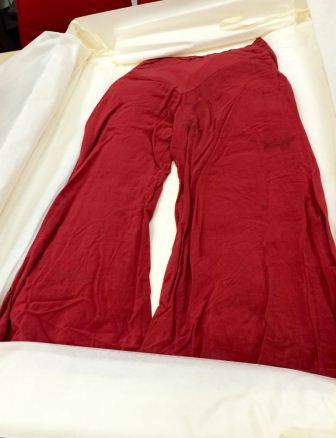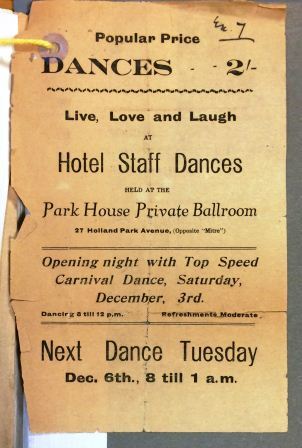
A red silk pyjama suit produced as evidence in R v Salmon, Austen and 33 others. Catalogue reference: EXT 11/131.
I had always heard an archive myth of the red silk pyjamas held in our collections, so I felt for this year’s LGBT History Month it might be time to order them up and take a look for myself. The outfit was collected as evidence in a court case regarding the ‘corruption of the morals of His Majesty’s liege subjects’ – essentially, the individuals were accused of running a brothel. The red pyjamas, or as it was noted on the list of exhibits, the ‘red costume’, was seemingly a lounge suit worn by one of the parties (CRIM 1/638). Slowly unpicking a story surrounding an item is an exciting process. The police reports are from many different perspectives allowing the scene to be pieced together.
‘Live, love and laugh’
On 20 December 1932 two undercover police offers were invited to a premises in Holland Park, and upon arriving they were each greeted with a kiss on the hand from a man in exaggerated makeup and an evening dress known as Lady Austin. Welcoming them in, Austin remarked: ‘Don’t go and get too fruity yet’.
Once inside the ballroom 50-60 people were found to be present. ‘One half of them were attired in evening dress, the other half being dressed in lounge suits. All were male.’ The set up was explained to the undercover officers; the men in dresses were termed ‘queenies’ and the men in lounge suits termed ‘kings’. The officers each adopted a role and, in keeping with their disguise, pretended to be a couple.
The police reports note that every so often the lights went out and squeals of delight could be heard.
A flyer included as evidence sums up the event with the compelling phrase ‘Live, love and laugh’. As the handbill notes the event was aimed at ‘hotel staff’, many of whom contributed oral testimonies to the case (CRIM 1/638).
‘Our cult’
At the time this type of event was considered a criminal activity, especially as there was a charge for entry, which led to comparisons with a brothel. The undercover police investigations led to a police raid on the Holland Park dance in the early hours of the morning.
As the premises were raided Lady Austin defended the dance, and when the police read out the warrant by Austin said, ‘Surely only members of our cult are here. What harm are we doing? You don’t understand our love.’
Ernest Smith, Chief Inspector, said: ‘What do you mean by members of our cult?’ He said, ‘Why Lady Austin’s camp boys of course. We all know each other and they are introduced here from Betty’s in Baker Street’ (CRIM 1/638).
This particular case is one of several in our collections that show what the gay scene of the 1930s was like. Despite their actions being deemed illegal at this time, individuals in the LGBTQ community attempted to create ways they could meet and socialise with people that were accepting. Our collection contains many flyers and tickets from similar events, which can now be found predominantly in files relating to police and court cases.
What is harder to judge is how many similar events went on undiscovered by the authorities. Such files demonstrate it was possible for LGBTQ individuals to have a vibrant social life, as long as it was away from the police gaze. This event occurred after only six such events at this location. Matt Houlbrook’s Queer London provides an excellent resource on the queer social scene in London at this time.
‘Only for love’
One of the court’s accusations was that the property was being run as a male brothel. When questioned by the police, the proprietor notes that he pays the staff, such as Mrs. O’Farrell 15/- a night for the floor and a 35/- charge for the band. He explains that the members are charged a minimal 1/6 to attend ‘so we don’t run it for profit, only for love, but of course you don’t understand that’.
Ultimately this police visit to the premises in Holland Park led to a prosecution on the basis of ‘diverse lewd, scandalous, bawdy and obscene performances and practices’ – essentially men openly having sexual relations with other men. Based on the police evidence Austin and others were charged. The file shows a list of over 20 names with ‘guilty’ written next to each (CRIM 1/638).
In the police statements Austin remarks: ‘Oh, dear, this trouble would be obviated if they made our love legal’. Indeed it would be over 30 years later that the Sexual Offences Act was passed, decriminalising homosexuality in England and Wales for the first time, albeit on unequal terms.
LGBTQ history can be incredibly rich and revealing – this month I urge you to wander into a local archive and see what you can discover.
This month we have two exciting events relating to LGBTQ history, a talk by Neil McKenna on Fanny & Stella: the young men who shocked Victorian England and Out of the archives, an LGBTQ zine workshop based on records held here.


Much whilst I really enjoyed reading this, I am getting rather fed up of the overall term LGBTQ being used when, actually, the story is about gay/bi men. Problem is using the term LGBTQ gives the impression that there are lots of things (be they historical, news items, films or whatever) about lesbians, bisexuals and trans people when, in reality we are talking primarily about gay men.
Hi Jan,
Thanks for your comment, you make a very interesting point. It’s true that in this blog post we are focusing on the experiences of gay or bi men. Because male homosexuality was illegal until the 1960s there are plenty of criminal records to use in researching this subject. This is not the case for female homosexuality which was not officially criminalised.
This isn’t to say though that there aren’t records relating to other sexualities and identities. Records relating to relationships between women can often be found in other records series, such as censorship or policy files. A good starting point when looking into these records is our research guide on gay, lesbian and bisexual history: http://www.nationalarchives.gov.uk/records/research-guides/gay-lesbian.htm
We’ve also published a number of blog posts and podcasts that you might find interesting on gender and identity in archives:
http://blog.nationalarchives.gov.uk/blog/pride-and-prejudice/#more-2496
http://media.nationalarchives.gov.uk/index.php/fictional-obscenities-lesbianism-and-censorship-in-the-early-20th-century/
http://media.nationalarchives.gov.uk/index.php/when-a-woman-is-not-a-woman-how-the-ministry-of-pensions-constructed-gender-in-the-1950s/
http://blog.nationalarchives.gov.uk/blog/documenting-lgbt-history-across-the-uk/
We’ll take your point on board, and continue to try and show fair representation of LGBTQ histories as far as is possible. This month we have a talk by Neil McKenna on Fanny & Stella: the young men who shocked Victorian England and Out of the archives, and an LGBTQ zine workshop which will look at our lesbian, bisexual and trans* related records.
Thanks,
Vicky
Whilst Lesbian relationships were not illegal (they had not discussed the issue with Queen Victoria or how they should approach the issue) however within the British armed forces for example Lesbian relationships were not allowed until very recent times and beyond the 1960s. The attempted marriages between Lesbians are also recorded in the General Register Office (RG) series where the Registrar General has in one case refused to issue a marriage certificate of the two people posing as ‘Man and Wife’.
I really loved this post, it was most interesting! I’d love to spend some time with these collections some day. Thank you for posting about queer history!